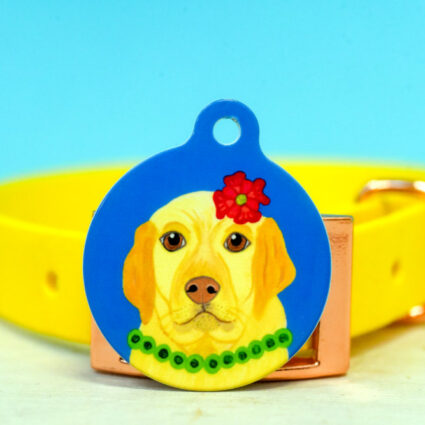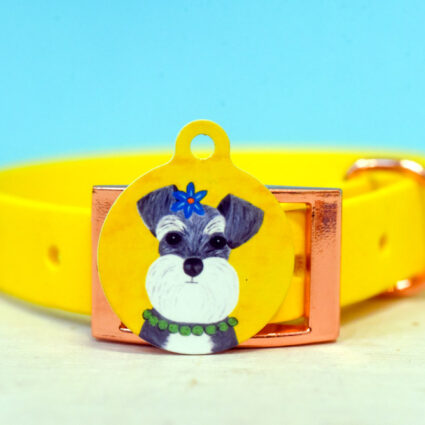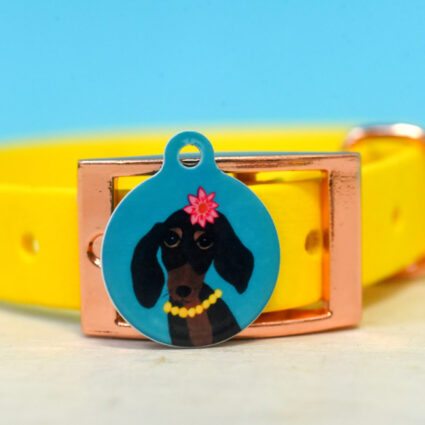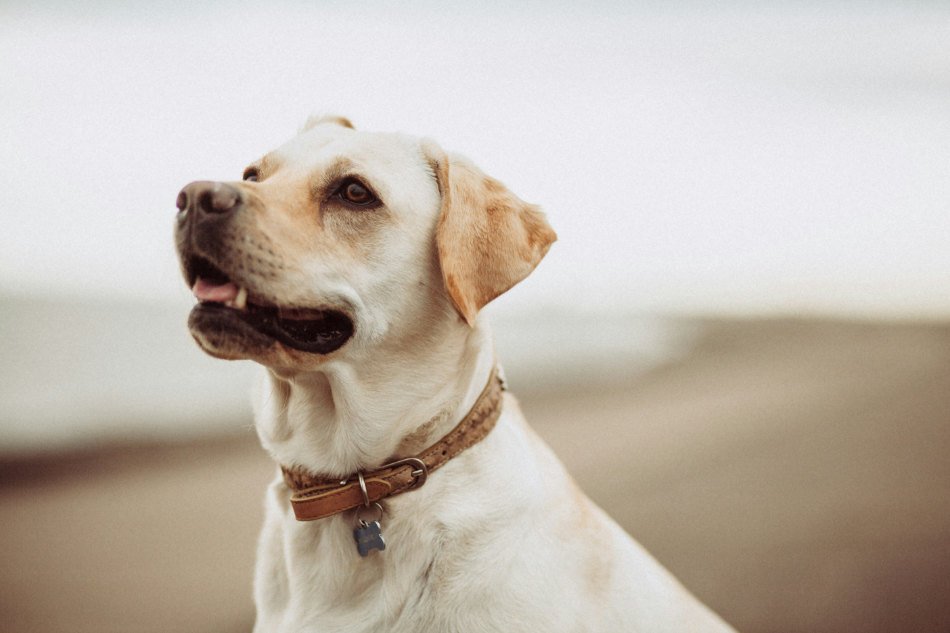
Many of us may ask: “do dogs like collars?” as we browse the endless rows of multi-coloured designs in any high-street pet store. The use of dog collars can divide dog owners and can lead to confusion about whether they are a positive or negative experience for pets. Today, many people are moving away from all types of collars and are opting for a good harness instead. With many pet owners confused, we analyse the essential facts about what to consider in a dog’s collar, how your pet will feel towards it and how to ensure they have positive associations with it. We will explore age-old questions such as: why do dogs wear collars? Do dogs like collars? What is the psychology behind dogs and collars? Do dogs enjoy wearing this accessory?
Why use a dog collar?
Dog collars are an integral part of dog ownership. They enable the owner and pup to experience the great outdoors together, exploring new places, meeting new furry friends, and ensuring that both owner and pup feel safe and secure away from their home environment. Many areas, that require close control of dogs, will enforce the use of collars and leads. This is common around farmland and grazing animals, as well as in areas of high numbers of people (especially children).
Do dogs like wearing a collar?
Dogs have been man’s best friend for millennia. Originally, dogs were valuable to humans who used them for hunting and for protecting livestock. Rock art panels in Shuwaymis (which date from 8000 years ago) depict dogs with a male hunter who are linked to him by leads.
Records show that basic dog collars have been used since ancient Mesopotamian times. The original Mesopotamian collars were simple cords, thrown around the dog’s neck. Over time, cord collars were replaced by ones made from cloth or leather which could be attached to a lead or a stick.
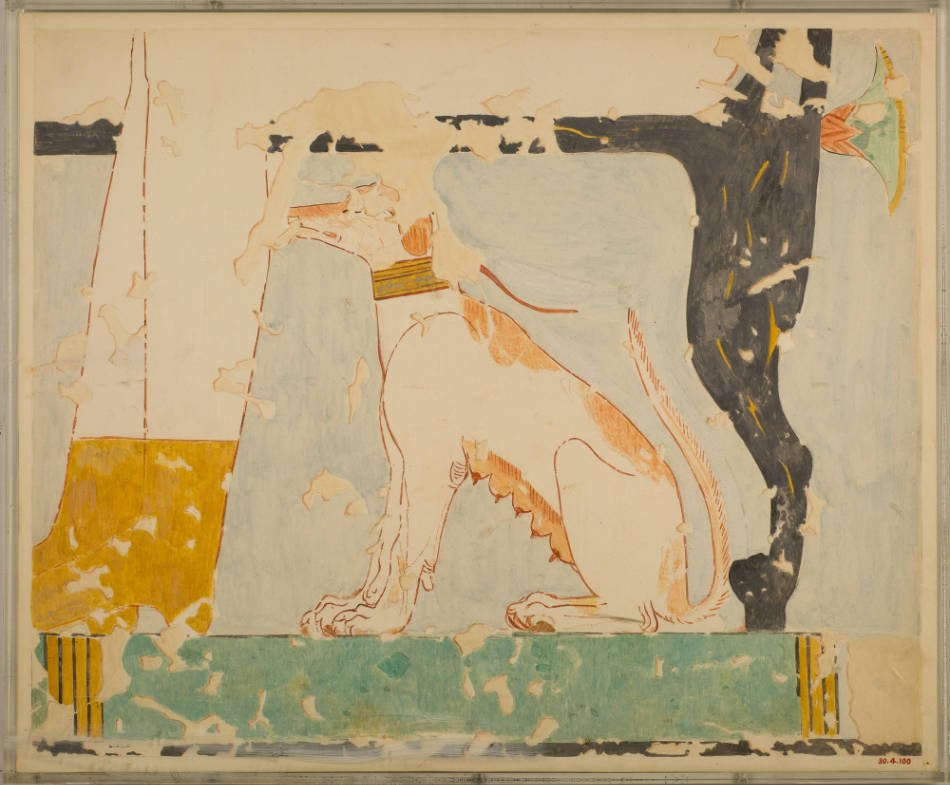
The oldest known fashionable dog collars come from ancient Egypt. By 612BCE there is evidence of ornate dog collars. Wealthy dog owners would demonstrate their wealth by adding gold ornamentation to collars.
A dog’s attitude to wearing a dog collar depends on their previous experience. Some dogs won’t mind wearing them at all and others will prefer to wear them only when necessary. For some dogs, wearing a collar is positively beneficial as it can reduce anxiety because it can enable them to anticipate upcoming events.
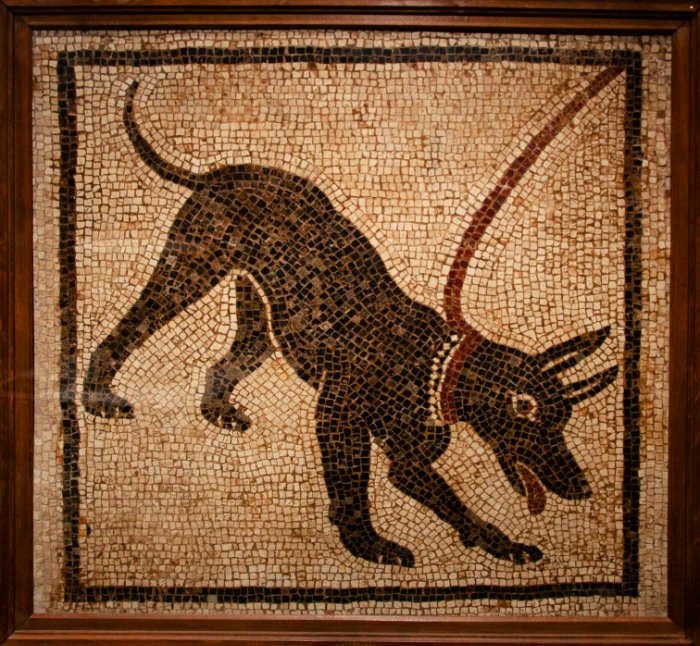
The link between man and canine companions has been recorded by artists and their works depict many different types of collars. The paintings by Alison Molan, for Pup Goes The Easel, continue this tradition. Alison’s fun, quirky and unique pup portraits depict dogs wearing brightly coloured necklaces. When painting bespoke commissions, for customers, she has been asked to incorporate bow ties and bandanas.
Unfortunately, if they have been previously mistreated by being made to wear a collar that is too tight or the material is uncomfortable, then their attitude will be negative. This may be true if they have been abused with choke chains. A dog will not want to wear a dog collar if it has sustained shock or injury whilst wearing a collar, such as, when its collar becomes caught on an object. In these situations, a dog collar may have negative associations with them. Happily, all dogs can be trained to accept wearing collars and this can be achieved through positive reinforcement such as by offering a food reward.
Dog collars and positive reinforcement training
Generally, if the pet’s collar is introduced gradually and is initially worn for short periods, your dog will not be worried about wearing one. If the use of a pup’s collar is also associated with positive experiences, this will ensure the dog is happy to wear a collar. In fact, many dog owners confirm that their pups become very excited when they are shown their collars because the dog associates the collar with going for a fun walk or going to the dog park to meet its furry friends. Dogs are creatures of habit and the wearing of a collar for pleasurable, and regular routines will ensure that they are happy to wear them and are able to enjoy the anticipation of happy times ahead.
Why do dogs like collars?
Collars have several functions that will have a positive association with dogs and are an extremely important aspect of dog ownership. They create a positive bond between owner and pup when associated with pleasurable walks and activities. Collars are also essential to keep your pet safe when it is used with a lead to take your dog outside. This instils confidence in you and your canine friend, reducing anxiety and stress. It also ensures that your dog is under control when it is in crowded areas, around livestock or children.
Dog-id tags, the ideal accessory for your dog’s collar
Another vital function of a dog collar is to secure your dog’s ID tags. Dog identification tags with the owner’s contact information, including a phone number, are a legal requirement, in the UK, for all dogs, when they are outside (except when dogs are being used as working dogs). The crucial information on these tags which are usually secured onto D rings, sewn into the collar, enables you to be reunited with your pet if it goes missing. Critical medical information can also be included on identification tags to ensure that whoever finds your lost pup will know what medical care or attention it requires.

Dog-ID Tags
A collar for all occasions
Do dogs like collars to be fashionable? Many dog mums would say yes! Collars are also, increasingly, becoming a fashion accessory for pet owners. Some owners have numerous collars and leads in a variety of colours and patterns to complement their own outfits or to mark special occasions, such as birthdays, Christmas, weddings etc. Whilst the dog may not appreciate the fashion statement they make, they will probably enjoy the fuss and attention it draws!
Does the collar fit comfortably?
It is important to ensure that the dog collar fabric doesn’t cause skin irritation and that it is kind to the dog’s skin. Whilst it needs to be strong and resilient, it also needs to be soft. Leather collars are a popular choice for this reason. The collar fit must be right. The collar must not fit tightly around the dog’s neck, but at the same time, it must not be able to slip over the dog’s head. Ensuring a proper fit means (however much of an escape artist your dog is) it will not be able to wriggle out from its collar! For a comfortable fit, you should be able to slip your finger comfortably between the collar and the dog’s skin. Any hair loss around the neck where the collar sits is an indication that the collar is a poor fit.
Types of dog collars
The first time you become a pet parent, you may want to seek advice from a dog trainer. They will be able to help you decide what type of collar would best suit your dog. For example, they will be able to assess what is the right collar for the size of your dog. There are a myriad of different types of collars on the market. You can buy a buckle collar, a flat collar, a rolled leather collar, a traditional collar and breakaway collars.
Breed-specific collars
Certain breeds have specific requirements, such as sighthounds which require a wider collar. For these breeds, you may opt for a martingale collar which many pet parents and dog trainers favour to keep their pets safe and secure. These are non-slip collars designed not to slip over slim-headed breeds such as Greyhounds, Whippets and the like.
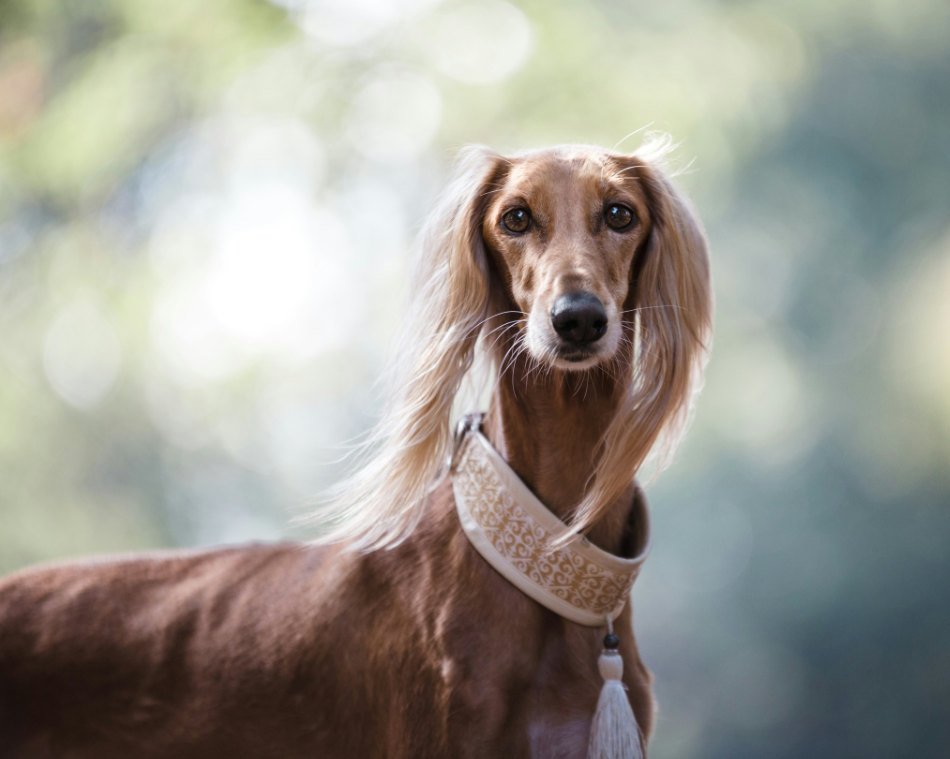
Safety collars
Stud collars, sometimes known as wolf collars are collars fitted with metal studs or sharp points. They are designed to prevent other animals from biting the necks of the dog. These collars have been used since ancient Greece, when dogs were used to protect livestock. Nail studded collars protected these guard dogs from wolves and other predators.
Alternatives to traditional collars
Some owners and their pups prefer to opt for something other than a traditional collar. Instead, there are other options, such as harnesses, that can help to keep your pet safe, confident and under control when walking on the lead.
Dog harnesses: a practical option for dog owners
Whilst collars are perfectly safe for well-trained dogs, harnesses are thought to reduce the risk of throat-related injuries, neck problems, and tracheal collapse. If a dog pulls, they may be more comfortable for the dog, as any strain is more evenly distributed across a wider area of their bodies. They can be a preferred choice for dogs who have spinal or orthopaedic issues.
Harnesses, however, can be fiddly to get on and off your pup and they need to be properly fitted to ensure the correct fit for your dog’s shape and size. If the lead is attached to the back of the harness, it can sometimes encourage pulling on the lead. A harness may also be hot for your dog to wear in warm weather and may cause it to overheat. As with the traditional collars outlined above, dog identification tags can also be attached to harnesses, to ensure their safe return, should they go missing.
Now you can decide between a traditional collar and a harness
So, when it comes to the question: “do dogs like collars?” we can safely say that it is a personal decision based on your dog and their prior experiences. Whether you opt for a collar or a harness, what matters the most is your dog’s comfort. Take time to decide what is the best option for your pup. And … don’t forget to buy a dog ID tag. If you want your pup to be safe and secure, to stand out from the crowd, and to make a fashion statement, why not opt for a Pup Goes The Easel ID tag? Each tag is lovingly and sustainably made in Britain. They feature one of 18 unique pup portraits and come in 3 different sizes. These unique identification tags can be fully customisable with your personal contact details on the reverse. Made from hard-wearing and weatherproof aluminium, these tags are a must for a pampered pooch.

